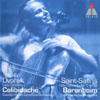Dvorák. Saint-Saëns Cello Concertos
Recordings of live performances which, although lacking the polish of Du Pre’s studio recordings, have great immediacy
View record and artist detailsRecord and Artist Details
Composer or Director: Antonín Dvořák, Camille Saint-Saëns
Label: Teldec (Warner Classics)
Magazine Review Date: 1/2001
Media Format: CD or Download
Media Runtime: 65
Mastering:
ADD
Catalogue Number: 8573 85340-2

Tracks:
| Composition | Artist Credit |
|---|---|
| Concerto for Cello and Orchestra |
Antonín Dvořák, Composer
Antonín Dvořák, Composer Jacqueline du Pré, Cello Sergiu Celibidache, Conductor Swedish Radio Symphony Orchestra |
| Concerto for Cello and Orchestra No. 1 |
Camille Saint-Saëns, Composer
Camille Saint-Saëns, Composer Daniel Barenboim, Conductor Jacqueline du Pré, Cello Philadelphia Orchestra |
Author: DuncanDruce
These live performances give a vivid impression of Du Pre’s spontaneity. There’s a feeling of living the music as it unfolds, which she didn’t always capture in the recording studio. Mostly this is connected with the quality of her tone – a little extra bow-pressure, or a particular character given to the vibrato – but it doesn’t sound at all calculated; it’s an expression of her engagement with the music at that particular moment. So these concertos make enthralling listening. There are drawbacks – a lot of audience coughs and other extraneous noises, and quite a few minor technical imperfections. At a concert, Du Pre would often throw caution to the winds; her magnificent but somewhat rough first entry in the Dvorak contrasts strongly with her controlled playing on the studio recording. The recorded balance of the Saint-Saens spotlights the cello, emphasising Du Pre’s passionate reading, but throwing out of perspective all the passages of dialogue (beautifully realised on the EMI recording) between cello and orchestra. Both Saint-Saens performances include an oddly lumpy, unappealing account of the minuet-like second movement, surely too slow for allegretto con moto.
The recorded sound for the Dvorak is excellent, and Celibidache lovingly shapes all the details of the colourful instrumentation, creating a luminous, fairy-tale atmosphere. Dreamy music like the end of the Adagio is drawn out almost to excess, though with great beauty – and the finale’s gait is strangely heavy (in partnership with Barenboim, Du Pre achieves a better balance between weight and liveliness), but this is still a remarkable, ear-opening performance.'
The recorded sound for the Dvorak is excellent, and Celibidache lovingly shapes all the details of the colourful instrumentation, creating a luminous, fairy-tale atmosphere. Dreamy music like the end of the Adagio is drawn out almost to excess, though with great beauty – and the finale’s gait is strangely heavy (in partnership with Barenboim, Du Pre achieves a better balance between weight and liveliness), but this is still a remarkable, ear-opening performance.'
Discover the world's largest classical music catalogue with Presto Music.

Gramophone Digital Club
- Digital Edition
- Digital Archive
- Reviews Database
- Full website access
From £8.75 / month
Subscribe
Gramophone Full Club
- Print Edition
- Digital Edition
- Digital Archive
- Reviews Database
- Full website access
From £11.00 / month
Subscribe
If you are a library, university or other organisation that would be interested in an institutional subscription to Gramophone please click here for further information.




